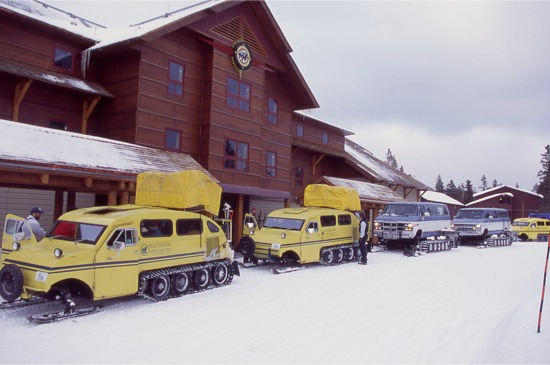Yellowstone National Park has released its new Winter Use Adaptive Management Plan, after over a year of discussion and debate.
According to a Yellowstone press release, the new plan is “the culmination of collaborative efforts by members of the public and park officials to use the best available science and public input to continually improve winter use management in Yellowstone National Park.”
Last summer, the National Park Service held a public comment period on their new winter plan. In addition, officials held a public meeting August 10, 2015 at the Visitor Information Center in West Yellowstone. These comments are reflected in the findings of the current plan.
You can download a PDF of the Winter Use Adaptive Management Plan here.
Under the new management plan, Yellowstone officials hope to reach three main goals:
1. To evaluate the impacts of oversnow vehicle (OSV) use and to help managers implement actions that keep impacts within the range predicted under the Selected Alternative.
2. To gather additional data regarding the comparability of impacts from a group of snowmobiles versus a snowcoach.
3. To reduce impacts on park resources after implementation of the Selected Alternative by gathering additional data regarding the overall social and ecological impacts of winter use and using those data to guide future management decisions.
The Winter Use Adaptive Management Plan covers issues pertaining to wildlife, soundscapes, air quality, “human dimensions,” technology, and the Non-Commercially Guided Snowmobile Access Program.
Winter use is a contentious issue in Yellowstone, especially regarding the role of snowmobiles. For instance, when the 2011 plan sought to curb the number of snowmobilers who could enter the Park on a daily basis, Senator John Barrasso (R-WY) penned a letter to Superintendent Dan Wenk asking the Park Service to consider upping the daily limit, citing the economic boost snowmobilers bring to area businesses and residents.
Overall, the current plan seeks to address each of the aforementioned topics (wildlife, soundscapes et al.) holistically. For instance, negative impacts from vehicle emissions and sound affect Yellowstone’s air quality and wildlife. And wildlife can impact vehicle use—sometimes literally—in response to distress or perceived harassment.
The plan also seeks to address future changes to Yellowstone’s winter season—especially effects borne out by climate change such as (among other things) diminished snowpack and erratic precipitation patterns. For reference, you can check out Yellowstone’s Climate Change Explorer, which compiles information about Yellowstone’s climate year-round.
 Yellowstone Insider Your Complete Guide to America's First National Park
Yellowstone Insider Your Complete Guide to America's First National Park





